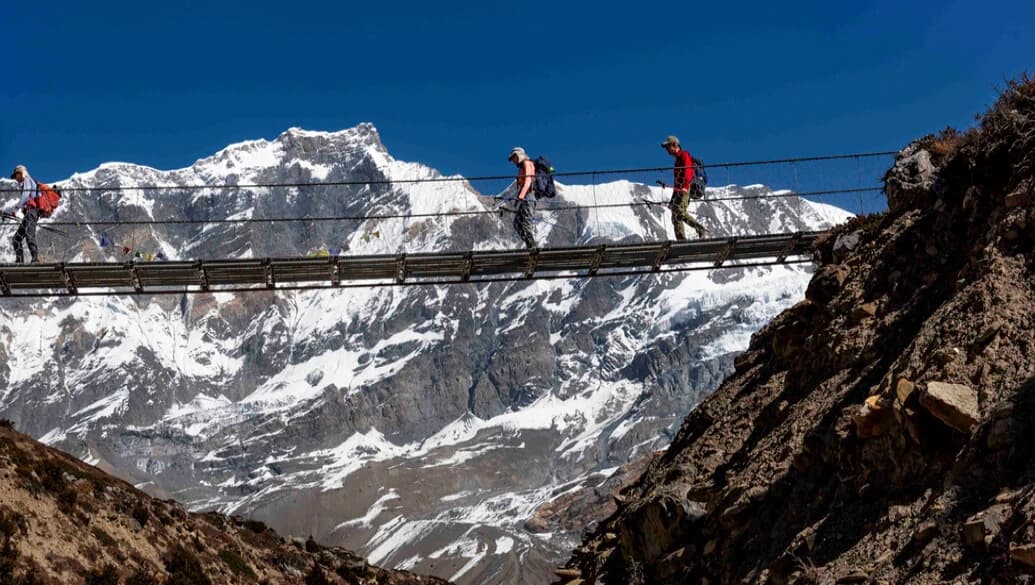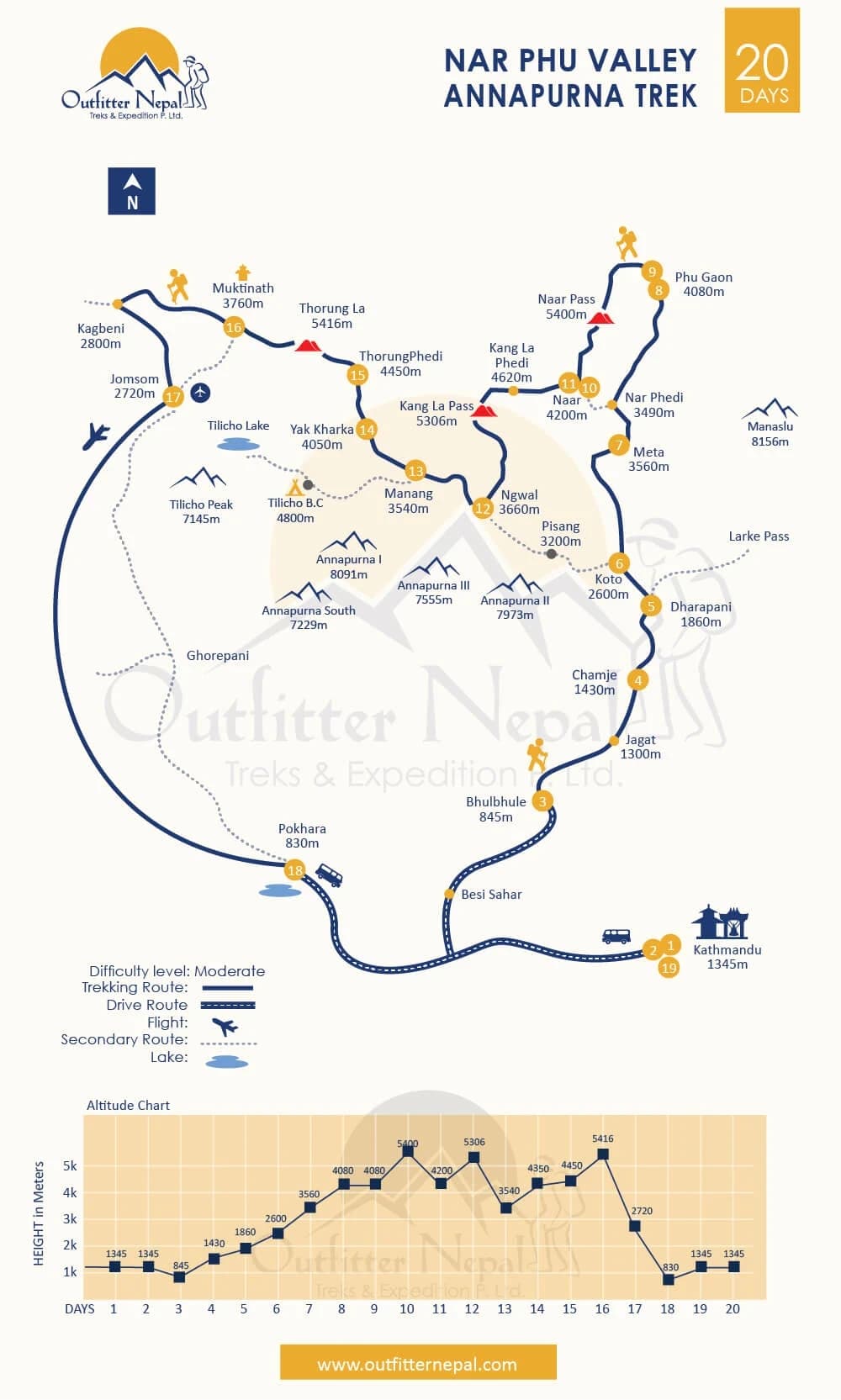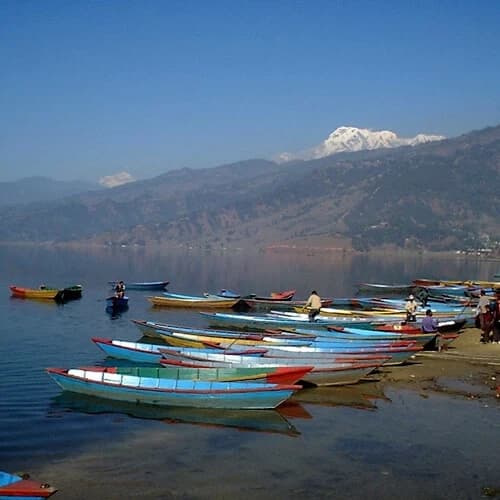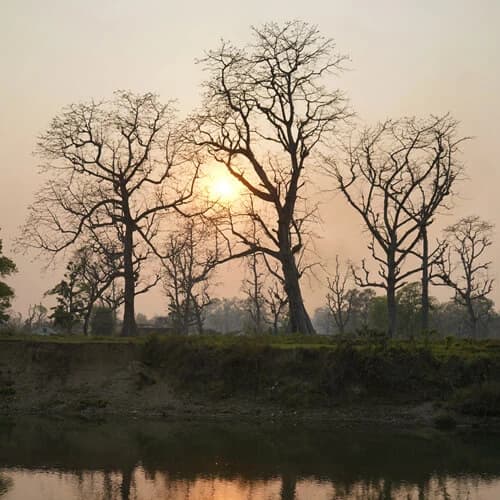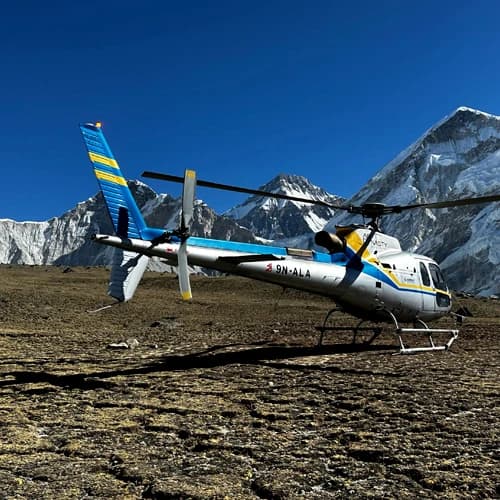Best Features of Annapurna Circuit with Nar Phu Valley Trek
- 3 weeks of continuous hiking in the remotest location in Nepal
- Full-day of sightseeing tour of the Kathmandu Valley
- Hiking on the off-the-beat and fairly less-crowded trail of the restricted area
- Staying in the ancient villages of Nar and Phu far from modernization
- Scenic drive from Kathmandu to Bhulbhule and Pokhara to Kathmandu
- Amazing mountain flight from Jomsom to Pokhara
- Wandering through the lush green woods of Rhododendrons, oak, birch, and juniper
- Surrounding yourself with 7000+ meters of mountain peaks
- Getting to know the locals of Manang village while acclimatizing
- Crossing the challenging Kang La Pass and Thorong La Pass
- Visiting Muktinath Temple in Mustang, a sacred Hindu and Buddhist shrine
- Witness panoramic views of the Himalayan Mountains
Annapurna Circuit with Nar Phu Valley Trek Overview
The Annapurna Circuit and Nar Phu Valley Trek offer an outstanding high-altitude trekking experience for seasoned trekkers. Even novice hikers can opt for the trek with some preparation and training. Annapurna Circuit with Nar Phu Valley is an unforgettable venture that leads to a hidden valley, where you experience a rich Buddhist culture and raw Himalayan nature. Trekking through pristine villages on a tranquil trail, you reach the small Nar and Phu villages. They are one of the most secluded parts of Nepal far away from modernization. The Nar Phu Valley Trekking route passes through serene settlements of people of Tibetan descent and blends the pristine natural appeal of the Himalayas with adventurous side trails and the famous Annapurna Circuit trekking trail.
This beautiful adventure takes you along some of the most breathtaking hiking trails in the world, with views of the seventh and tenth-highest mountains in the world, Dhaulagiri (8,167 m) and Annapurna (8,091 m). The walk is made much more fascinating by the Kali Gandaki River's world's deepest gorge. The cherry on top are landmarks such as the Thorung La Pass, Muktinath Temple, and the serene village environments of Manang and Jomsom.
Joining our Annapurna Circuit with Nar Phu Valley Trek itinerary, you will not only visit the two hidden villages but also get to explore other wonders of the Annapurna region. Exploring Manang village, you will cross the challenging Thorong La Pass and descend to Muktinath Temple. It is one of the holiest temples of Hindus and Buddhists. The trek further leads to Jomsom, where this adventurous Nar Phu Valley Trek of 20 days comes to an end.
Nar Phu Valley trekking in Nepal is available with Outfitter Nepal Treks and Expedition on both private departures and group-joining trips. Be part of one of our departure dates or contact us to create your tailor-made Nar Phu Valley Trek. We assure you that with us, you will not only get the most genuine cost but also the best service. Come join us on our 20 days full of adventure in the remote Nar Phu Valley Trek with Annapurna Circuit.
What does a brief Itinerary of the Annapurna Circuit with Nar Phu Valley Hike look like?
The Annapurna Circuit with Nar Phu Valley hike starts after a day's drive from Kathmandu to Bhulbhule, the trek start point. You start the trek by following the Marsyangdi River valley to Koto with an overnight stay at Chamje and Dharapani. You then leave the Annapurna trail and take another route to reach Phu Valley, spending a night at Neta village. After exploring the Phu Valley, you then trek to Nar village. You spend a day exploring Nar trek to Ngawal and finally trek to Manang village.
The Annapurna Circuit with Nar Phu Valley trekking excursion further continues from Manang towards Thorang La Pass. You again rejoin the classic trails of Annapurna Circuit to reach Jomsom by passing over the Thorong La, which is the highest trekking pass in Nepal with 5,416 meters above sea level. You visit the Muktinath temple and old Kagbeni village as well on the way to Jomsom. You then take a flight to Pokhara from Jomsom, spend a relaxing day in Pokhara, and drive to Kathmandu to conclude the trek.
How difficult is the trek to Annapurna Circuit and Nar Phu Valley?
The Annapurna Circuit with Nar Phu Valley Trek is one of the most difficult treks of Nepal. The trek includes long steep ascents on a rugged path. Moreover, this is one of the most isolated parts of the Himalayas, where there is no touch of modernization. The trail has few to no tea shops. Even only a handful of trekkers go on trekking in this region, which means you will rarely find fellow trekkers. All these factors add up to the difficulty level of this trek. Plus high altitude always involves the risk of acute mountain sickness as you’ll be trekking in altitudes of above 5000 meters. You must be in the best possible physical and mental condition because you will be walking over the challenging Himalayan terrain for six to eight hours each day. However, with proper guidance, a well-planned itinerary, and strong willpower, anyone can do this trek.
What is the best time to trek to Annapurna Nar Phu Valley?
Trekking to Annapurna Nar Phu Valley is best done in the spring months of March, April, and May, and in the autumn, from September to mid-December. Even better, October is thought to be the ideal month to hike in Nepal for the Annapurna region During this time, the sky is clear, making for fantastic views, and the weather is often consistent. The nice weather throughout these months adds to the enjoyment of the journey.
The hike is also feasible in the winter (December to February) and monsoon (June to July) seasons. However, during the monsoon season, there could be rain, treacherous terrain, and freezing temperatures.
If you want a more tranquil experience, you could go in December. The trek can also be done in the winter. Despite the very cold and snowy winter, clear skies and dry air offer the clearest visibility. Make sure you have all the gear needed if you're planning a hike in December.
In January, it is important to avoid traveling from Manang to Yak Kharka due to avalanches. There is a risk of landslides and avalanches on this path. Trekkers should proceed with caution from Manang to Thorong, no matter the season.
Major Attractions of the Annapurna Circuit with Nar Phu Valley Trek
Scenic drives and mountain flights
From Kathmandu, you drive to Bhulbhule at the beginning of your trek. The drive will be long and scenic. You get to see lush green hills, rivers, small settlements, dense forests, and waterfalls during the drive. On your return, you take an adventurous yet mesmerizing flight from Jomsom to Pokhara. You might witness the entire Annapurna range from your plane’s window. Likewise, the trip concludes with yet another amazing drive from Pokhara to Kathmandu across the countryside.
Exploring Pho Gaon & Nar Gaon tucked away from modernization
Pho Gaon and Nar Gaon are two separate villages in the hidden corners of the Annapurna region. Both villages are extremely secluded and untouched by modernization. You will spend two nights and one full day in each village to explore the surroundings and take in the people's quite different way of life from your own. Only a handful of trekkers get to visit this part of the region. You would be among the fortunate ones if you combined the Manaslu with the Nar Phu Valley Trek.
Crossing challenging Kang La Pass and Thorong La Pass
On the Annapurna Nar Phu Valley Trek, you will cross two challenging passes Kanga La Pass (in Nar Phu Valley) and Thorong La Pass (in Annapurna Circuit). Among them, Thorong La Pass is the most difficult one. It is the highest trekking pass in Nepal. The trail to both passes is steep and rugged. From the top of both passes, you can see the fantastic views of the Himalayan Mountains. It's impossible to put into words the feeling of accomplishment you get from seeing the breathtaking vista from the top of the pass. You must witness it for yourself.
Explore Manang and its surroundings
Manang is a very beautiful village with decent facilities from a hot shower to a nice lodge. However, due to elevation, everything is expensive here. You get to explore Manang and visit the nearby Buddhist monasteries and caves. Manange is the home of Buddhist descendants of Tibetans who speak Manange, a Sino-Tibetan language spoken in the northern Himalayas of Nepal. They are humble people who depend on tourism, yak herding, and a tiny bit of agriculture for their livelihood.
Visit the holy Muktinath Temple
Muktinath Temple, at the base of Thorong La Pass, is a popular destination for Buddhist and Hindu pilgrims. It is said that taking a bath in the hallowed faucets within the Muktinath temple premises would wash away all sins and bring good fortune. The abode of freedom, Mukti Kshetra, is another name for the temple. Thousands of visitors bathe under the taps at this temple, thinking the water will atone for their sins, coming from all across India and Nepal. During your adventure journey, you will have the exceptional chance to visit the Muktinath temple and ask for blessings for yourself.
Spend the night in breath-taking Jomsom
Jomsom is one of the most beautiful places in Nepal. You will explore the village and get to see some of the most outstanding landscape views. Also, Jomsom is the most developed village in the higher Annapurna region with an airstrip, WiFi, communication facilities, etc.
Witness panoramic views of the Himalayan Mountains
As you will be walking around the whole Annapurna range, you will undoubtedly see its mountains all the way from the beginning to the end of the hike. There are many peaks on this 55-kilometer long massif, including the 10th highest peak, Mt. Annapurna I (8091 m), Mt. Machhapuchhre/Fishtail (6993 m), Mt. Gangapurna (7455 m), and Tilicho Peak (7135 m). Along with these, you'll be able to observe summits reaching 7000 meters and above, as well as other mountains like Dhaulagiri (8167 m), Mt. Manaslu (8163 m), and Mt. Lamjung Himal (6986 m). There are going to be snow-covered mountains all around you.
Get to know humble locals from different ethnic backgrounds
The climb provides a fascinating look into the regional customs and cultural traditions in addition to a breathtaking view of some of the world's highest peak summits. While on the hike, you will get a chance to see how the Gurungs, Brahmins, Manangis, Thakalis, Bon, and Magars live in their traditional ways. The friendly locals will help you become familiar with the long-standing traditions, beliefs, and practices of the region. The numerous old temples, stupas, gumbas, and chortens that are still intact provide evidence of the region's rich cultural heritage.
